Affiliate links on Android Authority may earn us a commission. Learn more.
All the new HUAWEI P40 camera technology explained
Published onMarch 26, 2020
The HUAWEI P series is consistently on the cutting edge of smartphone photography and the HUAWEI P40 camera is no different. HUAWEI’s latest flagship series promises the familiar improvements to image quality, along with enhancements to AI processing and point and shoot software simplicity.
There’s a serious amount of imaging technology packed into this latest series. With that in mind, we’re going to break down everything that you need to know about the HUAWEI P40 camera setup.
HUAWEI P40 camera setups compared
There are three entries in this year’s series: the HUAWEI P40, P40 Pro, and P40 Plus. Each offers slightly different camera capabilities, starting with three cameras in the HUAWEI P40 up to a penta-camera configuration in the HUAWEI P40 Pro Plus. While all three share a bunch of common features, there are a few noteworthy differences. Here’s how each configuration stacks up in terms of raw camera specs (check out the full HUAWEI P40 series specs here):
| HUAWEI P40 Pro Plus | HUAWEI P40 Pro | HUAWEI P40 | |
|---|---|---|---|
Main camera | HUAWEI P40 Pro Plus 50 megapixels (RYYB) 1/1.28-inch sensor f/1.9 aperture 23mm focal length OIS | HUAWEI P40 Pro 50 megapixels 1/1.28-inch RYYB sensor f/1.9 aperture 23mm focal length OIS | HUAWEI P40 50 megapixels 1/1.28-inch RYYB sensor f/1.9 aperture 23mm focal length OIS |
Secondary camera | HUAWEI P40 Pro Plus 40 megapixels wide-angle lens f/1.8 aperture 18mm focal length | HUAWEI P40 Pro 40 megapixels wide-angle lens f/1.8 aperture 18mm focal length | HUAWEI P40 16 megapixels wide-angle lens f/2.2 aperture 17mm focal length |
Third camera | HUAWEI P40 Pro Plus 8 megapixels 10x periscope lens f/4.4 aperture 240mm focal length OIS | HUAWEI P40 Pro 12 megapixels (RYYB) 5x telephoto lens f/3.4 aperture 125mm focal length OIS | HUAWEI P40 8 megapixels 3x telephoto lens f/2.4 aperture 125mm focal length OIS |
Fourth camera | HUAWEI P40 Pro Plus 8 megapixels (RYYB) 3x telephoto lens f/2.4 aperture 125mm focal length OIS | HUAWEI P40 Pro | HUAWEI P40 |
Time of flight sensor? | HUAWEI P40 Pro Plus Yes | HUAWEI P40 Pro Yes | HUAWEI P40 No |
Bigger, brighter image sensors
At the heart of the HUAWEI P40 camera is a new 50-megapixel RYYB main sensor. For starters, it packs in more megapixels than the previous generation’s 40MP sensor. The camera produces 12.5MP pixel-binned images, compared with 10MP for the past couple of years. You’ll have to toggle the 50MP mode on in the camera app to view the high-res shots.
Large sensors result in higher dynamic range and cleaner images
The RYYB (instead of RGGB) sub-pixel layout sticks around after last year’s major rework of HUAWEI’s camera subsystem and algorithms. RYYB uses yellow pixels to capture 40% more light than traditional RGGB sensors, resulting in better detail and improved low light performance. This time around, HUAWEI is extending its RYYB technology to some of its telephoto zoom lenses as well. In theory, this should help reduce noise and improve detail, even when zooming in low light.
But the real headline feature with the HUAWEI P40 is the larger 1/1.28-inch sensor size. Bigger sensors capture more light, producing sharper images with superior dynamic range. For comparison, the P30 Pro and Samsung Galaxy S20 each offer a 1/1.7-inch sensor. Other flagships typically include just 1/2.55-inch sensors, including the Galaxy Note 10 Plus and iPhone 11 Pro Max. Bigger is definitely better here, especially in low light, as you can see from the sample image below.
Huawei’s closest competition for sensor size is the Samsung Galaxy S20 Ultra at a slightly smaller 1/1.33-inches across. However, that sensor is split into 108 megapixels for 0.8µm individual pixel sizes, or 2.4µm when binned. Samsung uses 9:1 pixel binning to produce 12MP images, while the P40 uses 4:1 binning for 12.5MP results. The HUAWEI P40 boasts ever so slightly larger 2.44µm binned pixel sizes, but it’s a pretty close contest between the two.
Of course, sensor and pixel size are just one part of the equation. Lens quality and image processing also play a major part in the final product.
10x optical zoom
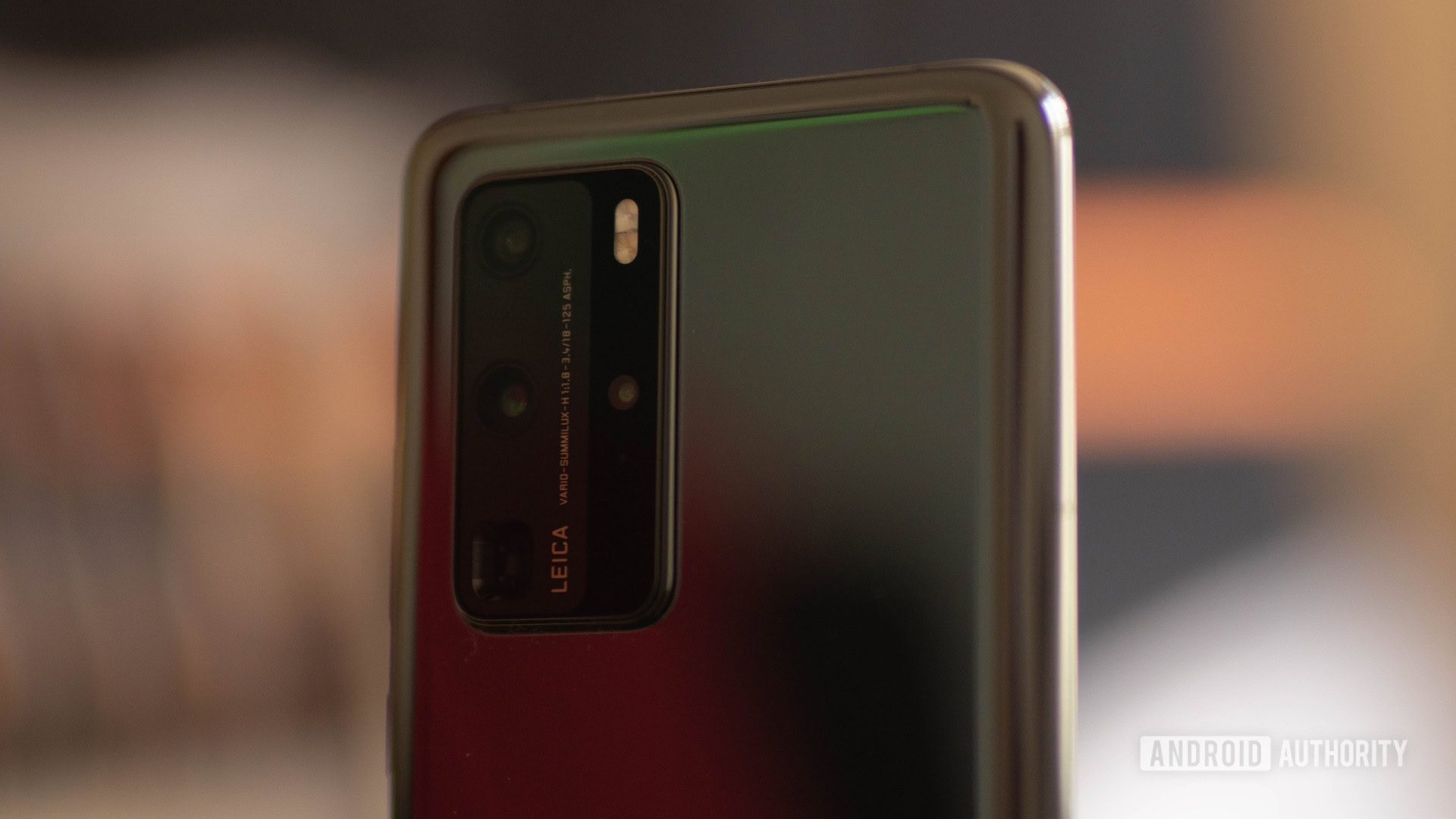
If you thought last year’s 5x optical zoom periscope camera was impressive, the HUAWEI P40 Pro Plus model is back with an improved 10x optical zoom camera thanks to a 240mm focal length. The handset is capable of zooming even further, through the use of “Super Resolution” zoom upscaling as well, although there is some loss in quality moving beyond 10x.
The key to achieving such long focal and optical zoom lengths is the use of a periscope camera design. A longer focal length essentially means a larger distance between the lens and the sensor. This would require a very large camera bump in a smartphone, which is why HUAWEI turns to a periscope design. The camera sensor and lens rest at 90 degrees along the inside of the phone and light is reflected towards it via a mirror. It’s a compact design that simply wouldn’t be possible using a telephoto lens setup.
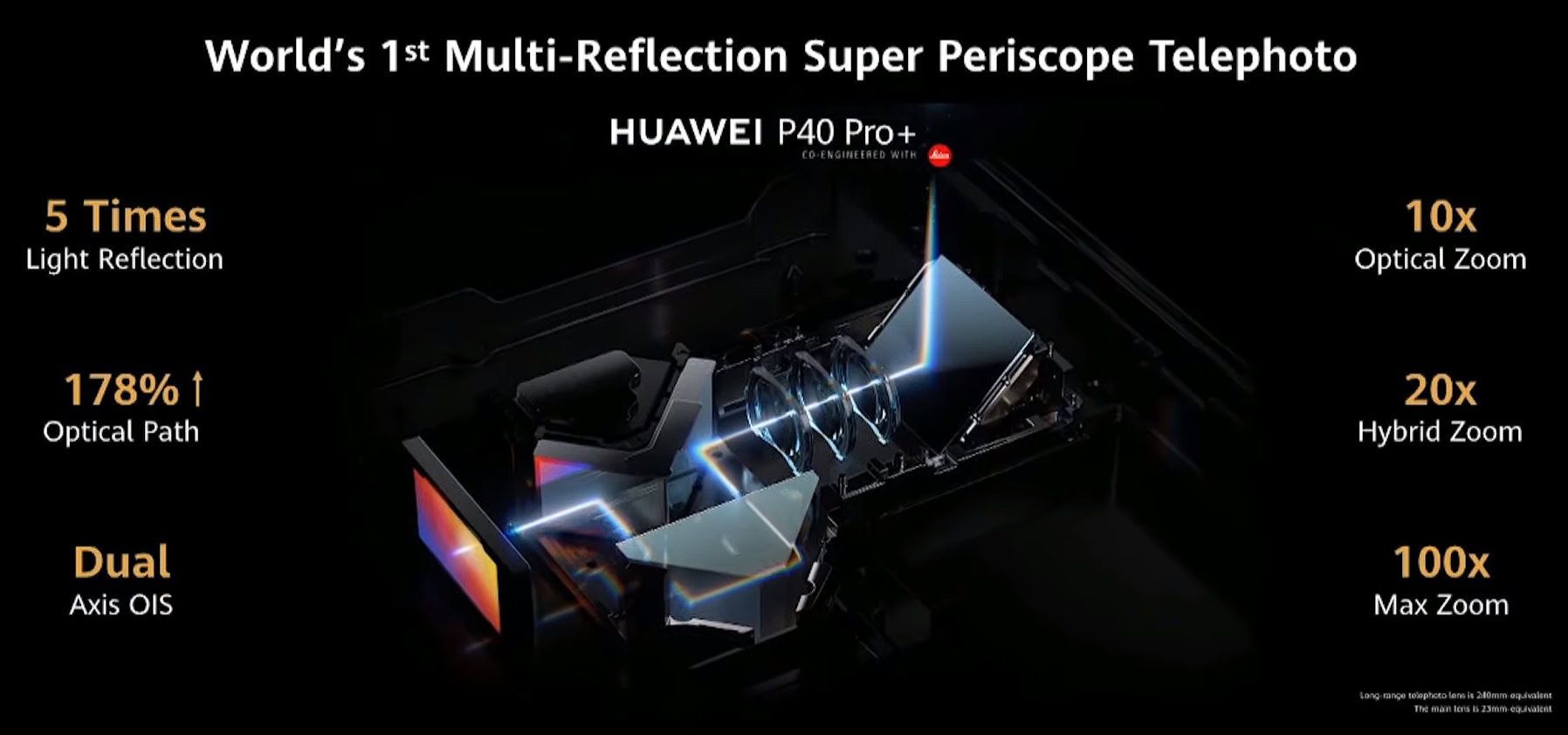
HUAWEI achieves its 10x zoom factor by reworking its previous generation 5x zoom technology. The camera’s focal length is related to the distance between the lens and the sensor. Increasing this distance increases the focal length, creating a longer zoom. To achieve this, HUAWEI uses light reflecting prisms to increase the distance light has to travel between the lens to the sensor. Angling the light at right angles takes up less space than simply extending the distance linearly, saving on area inside the handset and keeping the camera housing as small as possible. It’s pretty ingenious. However, we can’t help but wonder if all these reflections have any trade-offs for image quality.
Learn more: Why camera sensor size is so important
To ensure that the HUAWEI P40 Pro Plus still takes decent pictures in between max and minimum zoom levels, the handset also features a 3x telephoto lens with a RYYB sensor. The handset switches between these sensors automatically as you zoom in and out.
Octa-phase detection autofocus
Capturing the perfect action shot is an art, and it really helps to have a super fast auto-focusing solution inside your camera. Fortunately, the HUAWEI P40 series’ main sensor features “octa-phase” detection autofocus technology.
Every single pixel in the image sensor includes a phase-detection photodiode along with the light-capturing photosite. This means that every one of the 50 megapixels inside the camera is used to help focus the camera. The end result is much faster auto-focusing than ever before. You can see an example of just how fast and accurate the auto-focusing is in the GIF below.
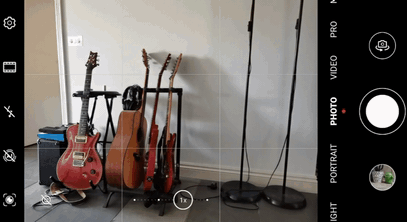
BM3D noise reduction
The Kirin 990 SoC and its integrated image signal processor (ISP) are at the heart of processing the HUAWEI P40’s pictures. HUAWEI’s latest image processing pipeline includes the mobile industry’s first Block-matching and 3D filtering (BM3D) noise reduction solution. This technique is typically associated with DSLR cameras and it’s a powerful denoise algorithm that can be run in close to real time.
BM3D is based on the idea of sparsity and “wavelet transforms,” where pixels groups are converted into the transform-domain and 3D data arrays. Sound complicated? In a nutshell, this technique allows for the smoothing of similar colors for noise reduction, while still retaining fine details and unique features present within each group.
Here’s a low light crop comparison between the P30 Pro and P40 Pro to demonstrate the improvement to detail capture:
This isn’t strictly a new feature for HUAWEI devices. The Kirin 990 and its BM3D noise reduction technology first appeared in the HUAWEI Mate 30 Pro.
XD Fusion Engine
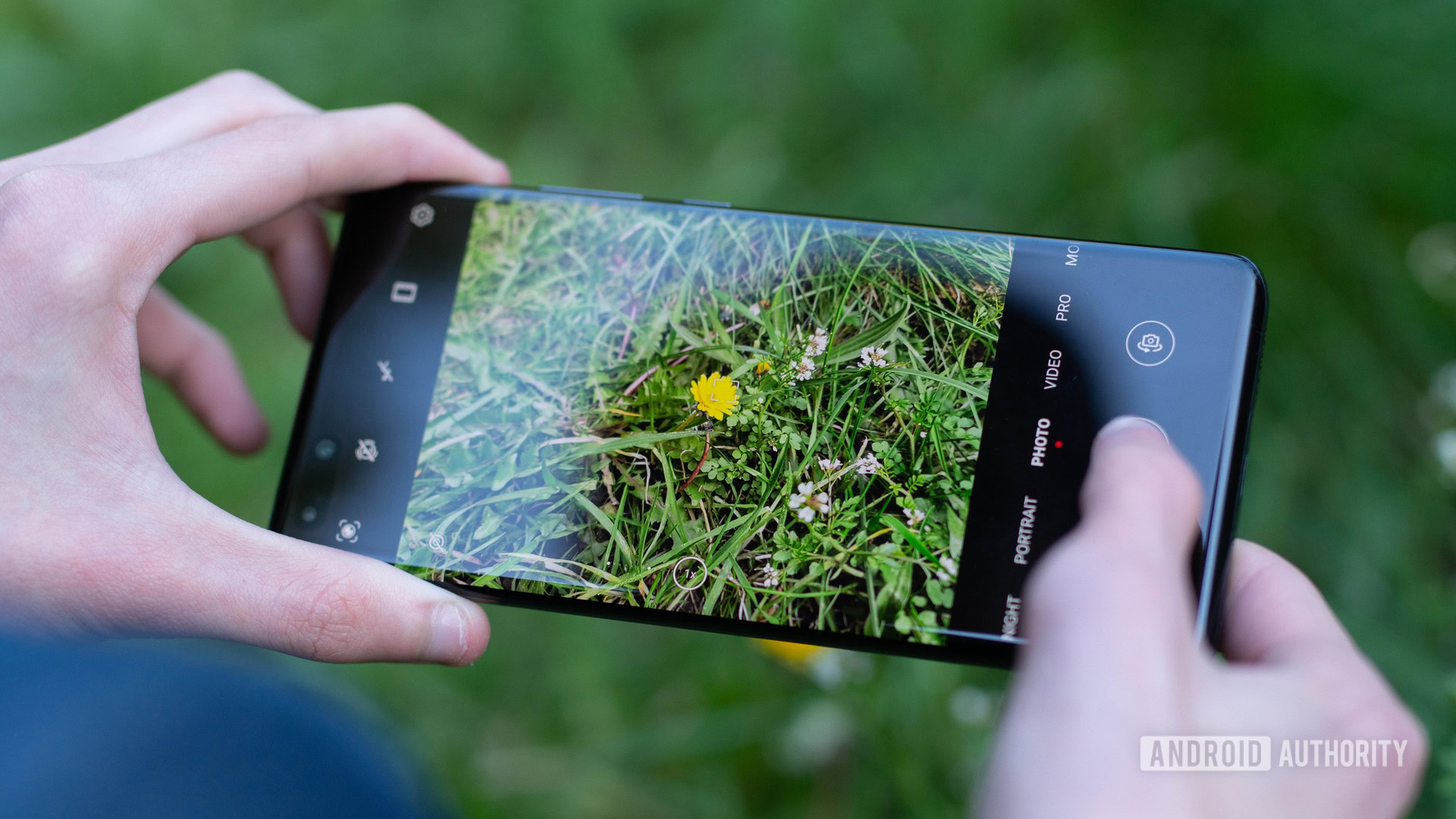
AI processing has been a key part of HUAWEI’s previous two launches and the HUAWEI P40 camera doubles down on photography smarts. Many of the company’s latest enhancements fall under the new XD Fusion Engine. This is the company’s third-generation AI engine for photography.
Read also: Camera software is more important than megapixels
The XD Fusion Engine uses the combined power of the Kirin 990’s ISP and neural processing unit (NPU) to run its various image enhancement algorithms. The XD Fusion Engine takes multiple frames from multiple camera simultaneously, using semantic analysis to calculate body and fast masks, identify landmarks, background, and more. The engine then tailors its imaging algorithms to the scene to extract detail, performing denoise, as well as color and dynamic range enhancements.
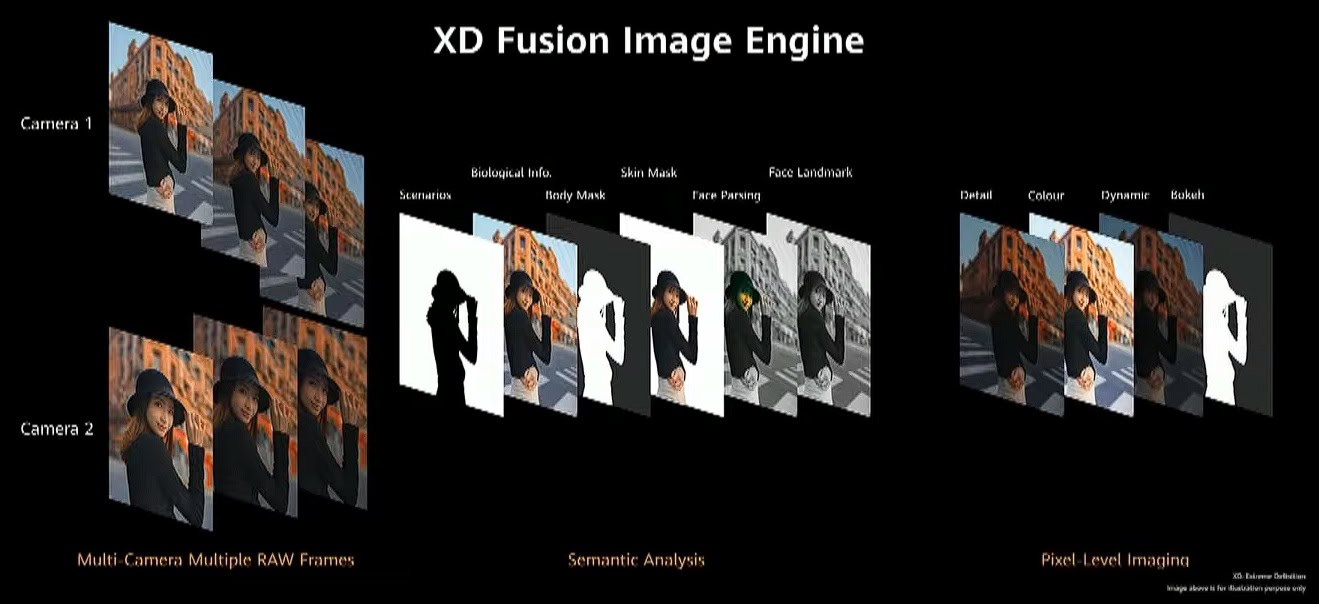
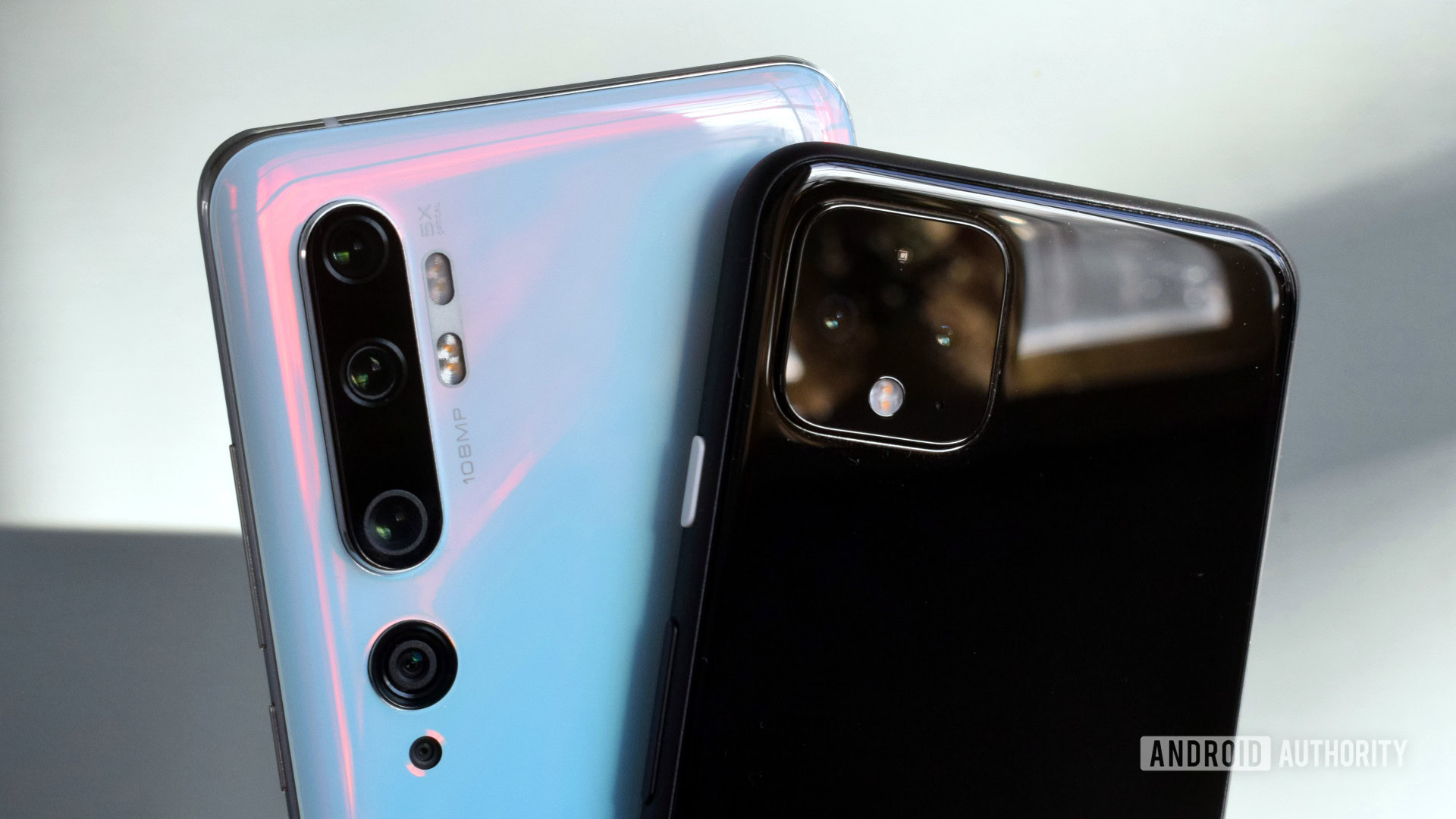
HUAWEI also uses its AI technology to enhance images in specific scenarios. For example, to improve skin textures, tone, and facial lighting for portrait shots, as well as providing that desirable soft bokeh blur. The handset’s multi-frame Super Resolution hybrid zoom technology is also part of this engine, enabling superior quality compared with standard digital zooming.
The HUAWEI P40 also boasts a multi-spectrum color temperature sensor powered by a new AI auto white balance algorithm as part of its AI photography suite. In addition, the phone’s NPU powers HUAWEI’s Best Moment feature, which suggests the best 3 out of 12 frames for live-action shots, eliminates pesky glass reflections, and even removes any annoying photobombers from your pictures. Part of HUAWEI’s mission this generation is to make photography simpler, and it appears that AI is the company’s key ingredient to achieve this.
With a combination of bleeding-edge hardware and machine learning capabilities under the hood, the HUAWEI P40 camera is as potent as ever. We’ll be putting these camera setups through their paces against the best shooters on the market very soon. For now, let us know your thoughts on the HUAWEI P40 camera tech in the comments.